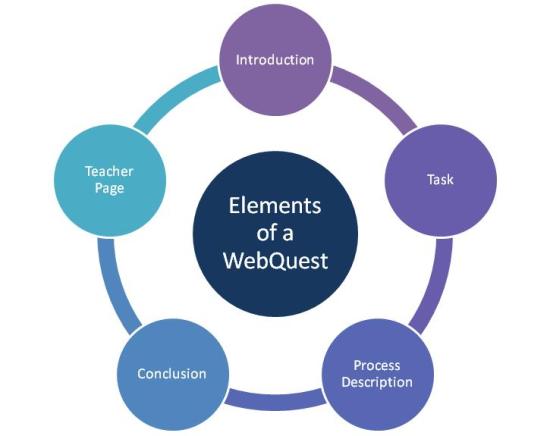Expert Talk
February 13, 2010 at 3:46 pm | Posted in Helpful Internet Services, Internet Learning, Lesson Preparation, Praxis, Technical Skills | 1 CommentTags: e-learning, internet, school use
WebQuests
January 20, 2010 at 12:34 pm | Posted in Helpful Internet Services, Internet Learning, Lesson Preparation, Technical Skills | Leave a commentTags: e-learning, internet, Lesson Plan, school use, useful URLs
What is a WebQuest?

A WebQuest defines a research project that encourages the students to
exploit certain websites and facilitates their self-learning strategies.
There is a nice introductory article on Lehrer-Online.com in which one can familiarize with the topic.
The WebQuest on WebQuests gives a nice introduction into the topic.
Elements of a WebQuest
A usual WebQuest consists out of 6 parts or elements.
(see diagram)
Introduction
The Introduction is used to raise the student’s attention and motivation for the upcoming task. Usually it introduces the central question or problem.
Task
The students have to solve a task, the central assignment of the WebQuest. It can be created according to topic and learners’ needs. It could include e.g. designing, deciding, creating, analysing and predicting.
Process Description
Here the steps are shown, which the students have to follow to complete their task. Additionally one can mention possible tools for the working process.
Evaluation
This includes a table with assessment criteria.
Conclusion
The Conclusion should include a summary of what the students have learned during the WebQuest.
Teacher Page
The Teacher Page ensures the availability of the WebQuest to other teachers with remarks and useful suggestions.
Example WebQuests
One can find a number of WebQuests on the WebQuest Database. I liked the WebQuest on The World of Shakespeare.
I liked this one because of its aesthetic layout, colour choice and its clarity. The formulation of the task is clear and understandable.
Furthermore I liked the exercises and creative work the teacher included into the Quest (e.g. students have to act-out a scene).
Create your own WebQuest
One can use two programs to generate ones own WebQuest.
The first one is called Aula 21. No registration required, you just enter your text and pictures and the program creates an html code. The program is free and one can quickly create a WebQuest like “The World of Shakespeare”.
text and pictures and the program creates an html code. The program is free and one can quickly create a WebQuest like “The World of Shakespeare”.
 WebQuest Wizard is another program that requires registration and that is more complex. It provides a web space and offers more designing opportunities than the Aula 21.
WebQuest Wizard is another program that requires registration and that is more complex. It provides a web space and offers more designing opportunities than the Aula 21.
8 Steps on how to create a WebQuest
The following steps give an overview of what steps are involved when you are creating your own webquest:
Advantages and disadvantages
I always like the idea that student’s experience as much exploratory-learning as possible. With WebQuests they learn to research and work on a schedule. The teacher only functions as a moderator. The students can work independently and are encouraged to creative processes. Additionally this form of learning is new to the students and more motivating than other methods.
On the other hand, creating such a project is very time-consuming. An enormous amount of preparation time is needed to collect and create the needed material. One has to master the complexity of such a project without loosing track of the learning aims and the topic.
Nevertheless I think this is a useful tool and I would include it in my class, but one has to keep in mind that only a well-structured and elaborated WebQuest is useful (especially on tasks, process and evaluation) and a GOOD one.
Web 2.0 Applications
November 25, 2009 at 8:04 am | Posted in Helpful Internet Services, Internet Learning, Lesson Plan, Lesson Preparation | Leave a commentTags: e-learning, internet, Lesson Plan, school use, useful URLs
During our last in-class session we talked about Web 2.0 applications and their use in school. One Blog gives an overview over some of them.
I picked applications, that I thought would be useful in class.
Collaboration
Meebo is a chat- platform that provides the possibility of instant messaging between icq, AOL, Yahoo!, Google and MSN.
Etherpad enables the users to chat in real-time, so collaborative work is possible. I liked this application because it is easy accessable and operable.
Bookmarking and Note-Taking
See delicious post.
Research
One should introduce google scholar and answers.com as alternatives to usual google research.
Study Tools
SparkNotes provides information about various academic subjects including literature and history.
Mind Mapping
Bubble.us and gliffy enable students to create mind-maps or flowcharts without registering.
Various Tools
Applications like google maps, google earth and the interactive periodic table of elements should be familiar to the students.
My group created a Lesson Plan with the applications bubble.us (mind-mapping tool) and answers.com (search engine). Additionally the students had to create a Powerpoint-Presentation.
Internet Learning Sites
November 19, 2009 at 2:22 pm | Posted in Helpful Internet Services, Internet Learning, Lesson Preparation | Leave a commentTags: e-learning, internet, internet-games, school use, useful URLs
During our last session we analysed certain internet learning sites. The analysis can be found in the Blog of our group.
I personally liked the site “Game Zone” because of its well-structuredness and variation. The site contains mostly grammar and vocabulary games for all learner levels.
I would recommend to use this site in school to additionally practice certain phenomena.
Scoyo.de – From F to A?
November 12, 2009 at 2:36 pm | Posted in Helpful Internet Services, Internet Learning | Leave a commentTags: internet, learning platform
Skoyo.de is a learning platform on the internet. It claims to be Germany’s biggest so far. The Slogan “Spielen, Lernen, gute Noten” sums up the general concept of the site. The program covers grades 1-7 and was created and based on the curricula of all German states. The goal of the platform is to combine learning with games to make it more interesting (“spielendes Lernen”).

Scoyo Overview English grade 6
I had the opportunity to take a look at the program in a test-version. My first impression was, that the site is VERY colourful. It contains a lot of pictures and comics.
The program for English, is divided into units namely “Vocabulary, Grammar and Pronunciation”.The tasks contain gap-texts, vocab-games and inter-textual exercises.

Scoyo English Vocab Game
Although the students listen and read new words for example the gaming approach is (earning credit points to improve level, a lot of games) too strong in this program. It is likely that the learners only concentrate on winning and not on the actual context. Furthermore, the grammar exercises do not contain an explanation of the rules or the context. The students are not asked to produce any texts and the interaction between learners is not given through the program.

Scoyo English Grammar Exercise "Present Progressive"
The fee for the program is 15 € per month and in my opinion parents have to closely observe children when using this program, because they can’t know at this age which exercises are suitable for them.
All in all I think it is rather difficult for young learners to stay focused when using this platform, because there are so many things that distract you. The program is useful for learners who are relatively independent and prefer the audio-visual learning approach. Students with problems in the subjects should rather not use the platform because it does not support such learners. It is a program to practice and improve your English if you’re already a good student.
Delicious- Social Bookmarking
November 12, 2009 at 2:30 pm | Posted in Helpful Internet Services, Lesson Preparation | Leave a commentTags: bookmarks, internet
Delicious is a social bookmarking site on the Internet.

Delicious Logo
One can save bookmarks on it and access them from every computer. Another possibility is to search for bookmarks for a specific topic. The site lists the bookmarked pages by frequency.

Delicious Search "Lesson Plan"
I think the site is very useful, if one does a general internet research. You quickly find the most common sites. In contrast to search engines like google the suggested pages are rated by users. I think this is a useful tool, that should function as an additional help finding information.
Problems with Internet Connection
November 2, 2009 at 10:08 am | Posted in Technical Skills | Leave a commentTags: internet, technical basics
There is always something: You need to write an important Email or you want to use the Internet on a research project with your students…and… the Internet doesn’t work.
Here are some suggestions how to fix the problem:
- Check if other websites are available
- Is the LAN cable plugged in?
- WLAN: is wifi-component switched on (LEP- lamp)?
- Re-establish the connection (stopping/restarting network service)
- Help (technician)
- And if nothing works: always have a backup plan!
Digital Schoolbag
November 2, 2009 at 10:07 am | Posted in Software | Leave a commentTags: internet, school use, Software, useful URLs
The “digital schoolbag” is a collection of software that is free and downloadable for school-use. One can download it via www.digitale-schultasche.de and store it on an 1 GB USB stick.

Digital Schoolbag
The package contains Skype, Open Office, several learning software, a VLC- Media Player, a CD-burner, nearly 40 programs.
The advantages are that one can play the programs via the USB-Stick, without installing them. Additionally the download is free, students can use the same software they use in school and the school computers do not need that much memory space any more.
I think that this is a great and easy way to integrate New Media into the classroom. It enables the students to use and get to know the media actively and encourages the teachers to use new teaching methods with the help of the software.
ESL PodCards
October 22, 2009 at 1:39 pm | Posted in Lesson Plan, Lesson Preparation | Leave a commentTags: internet, Lesson Plan, pictures, school use, useful URLs
The site www.eslpodcards.com provides listening exercises with worksheets to certain topics (mostly “Landeskunde”). The sound samples are sorted by country and topic.
Lesson plan
I created a lesson plan (grade 9, 45 min) with the podcard “Brighton” .
I chose this topic because I recently been to Brighton.
I would start my lesson by showing the pupils a picture of the Royal Pavillion in Brighton. I would ask them to guess where the building is situated (continent, country, city).

- Brighton Royal Pavillion
Because of its Indo-Saracenic style most pupils will probably relate it in India.
After this introduction I would use the listening exercise of the podcard. The site provides several activities. I would use the questions in activity 2.
Additionally one can use the other exercises that are provided from the site. One can download them via a pdf-file.
The next step would be Internet Research. The class is divided into two groups and each group researches one question.
Q1: What is the Brighton Pride Parade?
Q2: Why is the city called “Brighton and Hove”
If there is some time left, I would spend it, showing soms photographs I took during my vacation in Brighton.
Advantages and disadvantages
ESL PodCards provide an interesting alternative to ordinary teaching ideas. One can plan a lesson with very little work and time.
Nevertheless there are several things to consider when working with the website. One has to make sure to check whether the task is suitable for the group of learners and their language level. Additionally it is advisable to evaluate the provided material carefully. Some of the tasks might not be suitable or even unnecessary.
All in all the site can function as the “something different” one sometimes needs in class.
Blog at WordPress.com.
Entries and comments feeds.









In unserer letzten Sitzung führten wir ein Skype-Gespräch mit Herrn Donath. Die Studierenden hatten die Möglichkeit ihre Fragen zu stellen und der Experte beantwortete sie sehr freundlich und geduldig.
Er berichtete das er sich schon seit 1989 mit neuen Medien im Unterricht befasse. Seine ersten Erfahrungen sammelte er mit Email-Projekten. Seiner Meinung nach sind diese jedoch in der heutigen Zeit weniger attraktiv, da man viel leichter über Platformen wie facebook und Blogs kommunizieren kann.
In seinem Unterricht arbeitet Donath viel mit Lerntagebüchern in Form von Blogs. Außerdem verfügt die Schule, in der er arbeitet, über ein Multimedia-Zentrum “Bahnarum”. Hier können die Schüler an Gruppentischen mit Computern arbeiten, es gibt einen Beamer und eine Teeküche. Die Schüler verwalten den Raum selbst. Neben dem normalen Unterricht werden dort das Jahrbuch, Abizeitungen und eine englische Zeitung entworfen.
Um die Privatsphäre seiner Schüler zu schützen rät Donath Lehrern, den Schülern eine skeptische Distanz zu den Neuen Medien zu vermitteln und sie immer wieder auf entpersonalisierte Einträge hinzuweisen. Dies sollte ein Teil der so genannten “Medienerziehung” sein.
Der Experte schätzte den derzeitigen Anteil an genutzten Neuen Medien in der Schule auf maximal 20-30% ein. Zukünftig werden seiner Meinung nach immer mehr Laptop/Netbook-Klassen eingeführt werden. Herr Donath setzt sich für einen didaktisch wohl überlegten Einsatz der Neuen Medien ein, wobei der Computer ergänzend zu den “Alten Medien” genutzt werden sollte. Er hält ein Verhältnis von 50% Neue Medien zu 50% Alte Medien für durchaus realistisch.
Abschließend sind hier die Antworten zu meinen davor ausgearbeiteten Fragen:
1) Wie schätzen Sie den wirklichen Anteil an “Neuen Medien” in der Schule ein? Zu wie viel Prozent werden “Neue Medien” tatsächlich eingesetzt?
Der maximale Anteil des neuen Medien Einsatzes liegt bei 20-30%. Herr Donath selbst gestaltet 15-30% seines Unterrichts Web-gestützt. Er wies weiterhin darauf hin, dass diese prozentuellen Angaben für die Unterrichtssituation auch sehr stark von der vorhandenden räumlichen Umgebung abhängen.
2) Was muss getan werden um Lehrer zu motivieren, mehr “Neue Medien” einzusetzen?
Die Lehrer müssen in Fortbildungen stärker auf die schon vorhandenen Unterrichtskonzepte und Unterrichtseinheiten hingewiesen werden, sodass Medieneinsatz nicht unbedingt Mehraufwand bedeutet. Außerdem muss Lehrern (altersunabhängig) der Schritt vom Privatnutzer zum professionellen Nutzer (ebenfalls auch durch Fortbildungen) erleichtert werden.
Mir gefiel sehr, dass der Experte seine eigenen Unterrichtserfahrungen in das Gespräch mit einbrachte. Neben all den Möglichkeiten, die das Internet und die Neuen Medien bieten, sollte man sich jedoch gewahr sein, dass sie ebenso Gefahren (besonders für Schüler) beinhalten. Deshalb halte ich die “Medienerziehung” für einen unverzichtbaren und wichtigen Bestandteil des Unterrichts. Überdies teile ich die Meinung Donaths, dass man Neue Medien sinnvoll einsetzten sollte. Sie sollten ergänzend zu anderen Unterrichtsformen bestehen und in Zukunft das Lernen sowie den Unterricht verbessern.